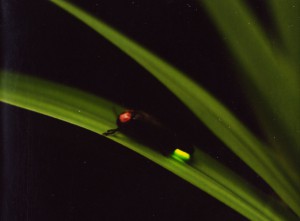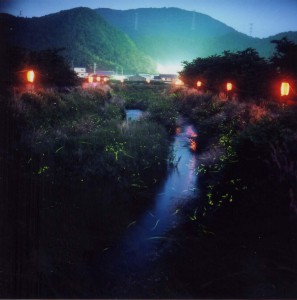Feature
Lights of the night
Clouds of fireflies once lit the darkness of rural Japan. By a Shiga riverside, impassioned locals are working tirelessly to keep their light aglow.
Pulling into the station, Ominagaoka appears at first glance like any other rural Japanese town. But venture down one of its dark forest paths and you emerge into an eerie world where one of nature’s loveliest spectacles takes place over a fleeting period each June. Here, by the gently flowing river, the dim lights of countless floating creatures rhythmically pulse in the darkness.
These are Amanogawa fireflies. Beautiful yet vulnerable, they exist in a delicately balanced habitat of outstanding natural beauty that has been a government designated conservation area for over 60 years.
The Amanogawa River really is one of the best spots in Japan to witness the annual spectacle of firefly breeding. And thanks to the ongoing efforts of locals, firefly larvae continue to hatch each June and a festival is held every year to coincide with this explosion of light. The insects are an integral part of this community and informal efforts have been made by generations of locals to preserve the population since 1926.
Although hard to imagine today, during WWII firefly numbers grew to such levels that a cessation of conservation activities was ordered for fear that the powerful glow emitted would attract allied bombers.
Not the most attractive of insects in daylight, the fireflies’ use of bioluminescence is really what sets them apart from other bugs of the night. This chemically produced light emitted from the abdomen is used rhythmically, ranging from a constant glow to sudden flashes, mostly to assist finding a mate for the night. Studies estimate there are around 2,000 species of firefly worldwide; however, Luciola cruciata, or Genjibotaru, is found almost exclusively in Japan.
Since WWII, insect numbers have sadly dwindled, with a combination of construction, increased use of fertilizers in farming, and the infamous Ise Bay typhoon in September 1959 bringing fireflies to the brink of extinction. According to a 2004 study by the Agriculture Ministry’s Takashi Tsuda, the problem began when the fireflies’ food, the Kawanina (black snails), began to disappear. Next came the post-typhoon reconstruction, which lasted for five years and caused changes to the river’s course and flow, thus depriving the insects of optimum conditions needed for their life cycle.
Something had to be done and in 1972 by-laws were introduced to once again protect the insects and their environment. Some dedicated locals even took to hand-rearing fireflies in their own homes.
So, what’s the situation like today? Well, numbers are creeping back towards pre-war levels, thanks largely to the ongoing dedication of the local volunteer group. Sacks of charcoal are placed in the river to filter the water, efforts are coordinated with local farmers to ensure huge sheets are spread across sections of the river during fertilization of fields, and the river is dredged every 10 years to keep the water free of debris. Tomohiro Nakagawa of the Maibara Council Tourism Department says that education is also key to protecting the area into the future. Nakagawa says: “Our volunteer group visits local elementary schools each year and provides classes to the students and parents, giving advice on how to look after the area and preserve the amazing fireflies.”
Where the tributary Yurigawa River meets the Amano River, you may be lucky to see up to 1,200 fireflies on any one night, performing their silent courtship among the trees. Slowly floating by, they aren’t the most difficult creatures to catch, but as their short lives permit only a few hours with which to find a mate and carry on the cycle, it’s best to just stand back, admire, and leave them to it.
 The annual firefly festival occurs in the town of Ominagaoka on June 8, which marks the start of the watching season. A Hotaru (firefly) Parade will be staged by local elementary schoolchildren at Rucchi Plaza in town, and will include a brass band and mikoshi (portable shrine). If you can’t make it on the 8th, don’t worry because the peak time for seeing fireflies lasts around two weeks. Also, an exhibition will be held throughout this period explaining the 80-year history of conservation around Amanogawa and the biology of the insects. There are various viewing spots along the river and at nearby Green Park, all within a 5-10 minute walk away from the festival’s hub of Rucchi Plaza. Here you’ll find the exhibition and food stalls, plus everything you need to know at the event information desk.
The annual firefly festival occurs in the town of Ominagaoka on June 8, which marks the start of the watching season. A Hotaru (firefly) Parade will be staged by local elementary schoolchildren at Rucchi Plaza in town, and will include a brass band and mikoshi (portable shrine). If you can’t make it on the 8th, don’t worry because the peak time for seeing fireflies lasts around two weeks. Also, an exhibition will be held throughout this period explaining the 80-year history of conservation around Amanogawa and the biology of the insects. There are various viewing spots along the river and at nearby Green Park, all within a 5-10 minute walk away from the festival’s hub of Rucchi Plaza. Here you’ll find the exhibition and food stalls, plus everything you need to know at the event information desk.
The Amanogawa festival is unique in that it supports a real conservation project. Each June, it aims to put the spotlight on fireflies, educating visitors about the journey these insects have taken over the last century and how their numbers are intrinsically linked to human activity and understanding. At this particular show, the fireflies are the stars, and long may they remain so.
[box]
Getting there:
 Catch the JR Biwako Line to Maibara and change to the JR Tokaido Main Line bound for Ogaki. This is just an 8min ride to Ominagaoka Station. From the station it’s just a 5min walk to Rucchi Plaza adjacent to Santo library, just 800 metres from the station exit across the river off route 244.
Catch the JR Biwako Line to Maibara and change to the JR Tokaido Main Line bound for Ogaki. This is just an 8min ride to Ominagaoka Station. From the station it’s just a 5min walk to Rucchi Plaza adjacent to Santo library, just 800 metres from the station exit across the river off route 244.
When to visit:
The festival starts on June 8th. An exhibition will be open throughout the duration of the firefly’s activity, which will usually be 2 weeks from opening day. Peak viewing is between 8-9pm.
Tips for your trip:
Maibara Council have requested that visitors use public transport to avoid congestion. Please visit responsibly to minimize your impact on the area – take all your trash back with you and resist the temptation to catch the insects! Torches or camera flashes may disrupt the fireflies.
[/box]













